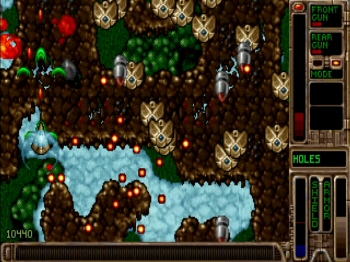
The opening levels have floating platforms over the planet’s clouds and terrain. The first boss actually makes a fly-by at a lower altitude before engaging you in battle. It’s little touches like this that makes Tyrian stand out.

While both Arcade and Full Game Modes have their respective ways of upgrading weapons, these chrome capsules will immediately advance either the front or rear cannon by one step.
Review by Jay Wilson I return again and again to a common theme in my reviews: that video games are about options; however options lead to complexity, and while complexity is not inherently bad, it can lead to dead time in the form of learning curves, arbitrary barriers, or maintenance. So the trick is to give players the most options while maintaining maximum simplicity. How does a developer strike this balance? Well, many factors play a role, but cutting unnecessary choices will help the same way Strunk & White’s Elements of Style calls for any self-respecting author to eliminate unnecessary words from their prose—if it doesn’t add anything in any significant way, then it doesn’t need to be there. The other major factor to taming the complexities of multiple options is to implement an intuitive interface that simplifies the choices. And few games demonstrate these principles better than one of my all time favorites: Tyrian. The player takes control of a space ship flying over planets, asteroids, and through outer space in this futuristic sci-fi themed vertical-scrolling shooter. And before we even get into the actual gameplay, Tyrian offers meaningful options: Full Game or Arcade Mode. The latter, naturally, plays like the full blown cabinet classics such as Raiden and 1941: Counter Attack where all power ups and upgrades appear in the missions after destroying certain enemies, providing an uninterrupted experience for those wanting to see how far they can get on a set number of lives. Insert quarter, play till you die. Full Game, on the other hand, offers an evolving story and lets the player pick and choose ship upgrades at their leisure between missions in addition to granting them the ability to save and come back later for the player who wants to custom build their spacecraft or just kill fifteen minutes waiting for the pizza to arrive. In either mode, you get a ship equipped with armor, recharging shields, a front cannon, a rear cannon, and two sidekicks (additional weapons that hover on either side of your vessel). Sounds like a lot, and it is, but all the guns and most sidekicks fire when you push one button so the vast arsenal doesn’t weigh the game down with clunky complex controls; there’s just a lot more ammunition flying around. And I love how every tap of the trigger floods the screen with pure uncut firepower in the final episodes, inspiring me to quote Robert Oppenheimer “now I am become death ...” as I annihilate entire armadas and alien civilizations. One weapon, the Guided Micro-bombs, goes to such extreme that I actually lose track of my ship (powered up, it launches twenty-four smoke-trailed spheres per second, and all of them lock on, track their separate targets, and detonate.) But that’s okay because Tyrian provides plenty of other less distracting choices with plenty of other cool properties to choose from. And, who knows, maybe someone else doesn’t find the micro-bombs so distracting; maybe someone actually prefers them. That’s great. “Unnecessary options” does not mean “options I do not like.” 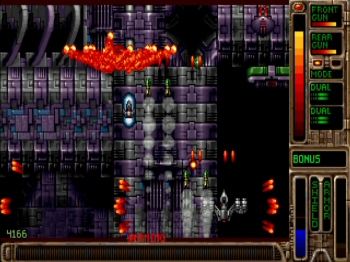
The ship icon in screen-center is an additional powerup that cannot be purchased; it must be collected in the level (even in Full Game mode). That particular one fires a beam of light, damaging all enemies it touches.
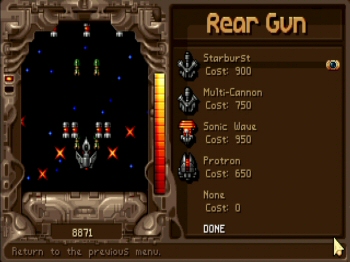
The red-to-yellow bar is the power indicator; a generator that stays consistently in the yellow means it can fire all weapons and recharge the shields at the fastest possible rate.
Everyone can find a setup they enjoy because the weapons by and large do not replace each other. The Starburst (a rear gun) is not a more powerful version of the Proton (also a rear gun). Some cannons fire concentrated blasts straight forward, others focus their firepower on the flanks (the aforementioned Proton), while others shoot in all directions; a few provide a constant stream of projectiles that circle the ship like a shrapnel shield (Starburst); and many rear guns have a secondary firing mode allowing it to switch directions at will. Most weapons fire across the entire screen, but the flame thrower side kick offers an ultra powerful short range inferno for the daring who want to fly point blank and drain the hell out of their generator. This translates to being able to hit and kill different enemies in a given scenario which affects what you have to dodge and directly impacts the all-important gameplay. I personally go with front-facing weapons which makes levels where enemies come from behind a nightmare because I have no choice but to take evasive manuevers until I can get into position to blow them away. In another level, enemies flank the screen and shoot sideways through indestructible barriers that prevent my ship from lining up for the kill shot which means I’m stuck in the middle of a laser gauntlet with only two things to do: dodge and pray. A set of 360° front and rear guns would make both these levels much easier, but I really like my Vulcan cannons, and if I switch it might be several missions before I can get them again (if I can get them back at all ... Vulcan cannon sidekicks are very very rare.) On the flip side, other levels have powerful ships that take an armory of bullets to destroy, and a set of 360° guns fail to get the job done which means avoidance tactics while hoping you don’t get boxed in and slaughtered; however, my concentrated Vulcan arsenal can and does, indeed, shred through damn near anything in front of my ship so I don’t have to worry about getting killed in a corner. I make my own doors. And again, having up to four separate guns adds no unnecessary gameplay complexity; one button fires all weapons. The hardest part is picking them out which brings me to the upgrade screen. Between missions in Full Game Mode, the player can purchase a new ship, shields, front cannon, rear cannon, sidekicks, and a generator, and this is made much easier because Tyrian does not lock you into a purchase by implementing an arbitrary buy/sell system that has no business being in a game like this. It gives a full refund for previously purchased upgrades, allowing you to start re-spending from scratch with a full wallet so there’s no reason not to experiment to your heart’s content. The upgrade screen also simplifies the selection process by offering only a handful of upgrades at a time and frequently changing the available options, gradually introducing you to the entire arsenal and giving you time to test drive a few before unveiling more. This simultaneously and unavoidably introduces a welcomed, albeit sometimes annoying, complication because the player always runs the risk of not being able to immediately get back a particular upgrade unless they have a save to fall back on (episode IV in particular has a long stretch where no upgrades are available since the missions happen back to back to back.) 
Most side kicks rigidly remain abreast with your ship, but these two geen orbs instead trail one step behind which allows you to place them in the line of fire and continue hitting an enemy while your ship remains safe.
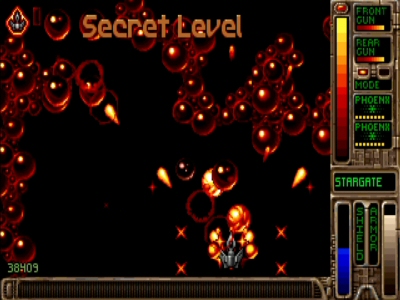
Killing key enemies will spawn these large amber spheres which takes you to a secret level in the next mission.
While the choice of guns is preferential, the choice of ships, shields, and generators are limited and linear (ie, better and better versions at higher and higher prices with no reason not to upgrade), nevertheless, a player can still continue on with an inferior ship (which affects armor) or shields if they don’t have the money and don’t want to downgrade one of their main guns for the needed cash. If someone wants to keep a low armor ship because they can get by on shields alone and would rather put that money towards offense, they can do just that. But I tend to use the recharging shields as another weapon by ramming small enemy vessels because maybe I can’t get all the way across the screen to shoot down an enemy, but I can reach him in time to kamikaze his ass because it dents my shields, my shields recharge, and no damage done. A simple and intuitive option—just fly into another ship—and once again it meaningfully changes how the game plays and makes Tyrian stand out from other shooters. Do I have to push anything to recharge the shields? Nope. Not a thing. They recharge on their own. Naturally, I don’t do this too often because shields only recharge so fast and armor does not recharge by itself; and naturally, I don’t go ramming ships multiplicatively larger than mine because of common sense brick wall physics. So I tend to keep my shields as well as my generator and ship top of the line even if I have to downgrade weapons or ditch the sidekicks; I’ll also downgrade my weapons early on for certain sidekicks (the rare Vulcan cannons) assuming, of course, I don’t have to downgrade them to the point of being useless. And while you can get a different left and right side kick, I always buy them in pairs to appease my obsessive-compulsive sense of symmetry. Sure, that makes purchasing more complicated when I can afford one sidekick but not both; however that’s my doing, and I’m willing to live with it. But Tyrian’s main stroke of genius is the inclusion of a strategic complication: the generator which powers all the weaponry and recharges the shields, creating a potentially crippling bottleneck if it cannot keep up with your arsenal, leading to some tough decisions: do you proceed into the mission and periodically lay off the trigger, dodging enemies and their projectiles, to let your shields recharge? Do you swap out your existing arsenal for a different setup that does not hit the generator so hard? Or do you pick sidekicks with limited ammunition and thus fire only when you want them to so you only drain the generator in small controlled bursts when you really need the extra firepower? These are interesting choices that radically change how you play the missions, and, most importantly, they do not weigh the game down with dead time because of the brilliance of the upgrade screen’s layout. 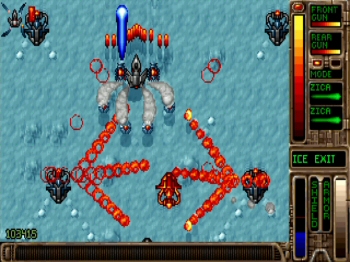
The original release of Tyrian was a standard single episode shareware game. The first registered release contained three episodes. Episode IV came later; and the re-release (Tyrian 2000) introduced Episode V; however, I still consider Episodes I-III to be the true game.
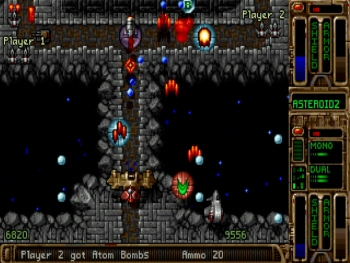
In Two Player Arcade Mode, one player controls the Dragon Head which acquires the front gun power ups; the second player controls the Dragon Wing which acquires the rear gun power ups and side kicks.
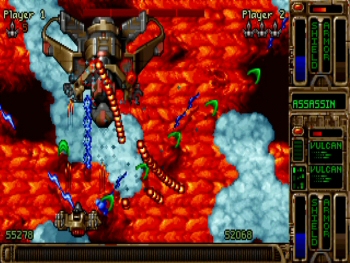
The Dragon Wing and Dragon Head can unite whereupon Player One flies both ships while Player two operates a 360° turret for some interesting interactions and tactics.
Weapon choices appear on the right, a demonstration of your current configuration in action appears on the left with the real time impact on the generator occupying the center. If you pick top of the line everything and go with a cheap bargain basement generator, the demo ship will quickly sink to a pathetic trickle of occasional main cannon shots with no sign of anything else. No rear gun, no sidekicks, and no recharging shields. Thus, even though Tyrian is loaded with possible customizations that can keep an engaged player returning again and again to perfect their creation, it keeps the necessities of ship configuration simple; at a glance you can tell if you’ve overloaded your power source. A player stays in the upgrade screen because they want to, not because they have to, and that’s fine. Plus if you don’t want to mess with the generator or upgrade screen at all, remember there’s always Arcade Mode. Now, when I first play a game, I like to immerse myself in the experience and watch the intro, sit through the cutscenes, read the dialogue, and so on; however, when I come back to a game, I return purely for the gameplay, thus I like to skip everything else. Tyrian caters to both playthroughs by presenting its story as a series of communication transmissions (data cubes) collected during missions. But the player doesn’t have to read them; they’re not even obligated to pick them up. It’s there for the players interested in the escalating conflict of a pilot brought into a war against the evil Microsol Corporation, but Tyrian does not penalize those who just want to jump in, pick out their gear, and blow shit up. Even with its secrets, Tyrian does not force players to spend hours in a game mode they don’t enjoy just to unlock basic content like modern games do. It comes loaded with hidden modes—one of which plays like the shareware classic, Scorched Earth—accessed via code. And yes, the game rewards players for beating an episode by giving out these codes, encouraging them to keep playing so they can recieve more, but the codes also work from a fresh install allowing anyone with Tyrian 2000 to jump into Lord of the Game by typing engage at the title screen. Simply put, Tyrian provides a classic video game premise, offers addictive options to get through its episodes, and then lets us, the gamers, do whatever the hell we feel like doing which is how games are supposed to work. | ||||||||||||||||||||
|
| ||||||||||||||||||||
